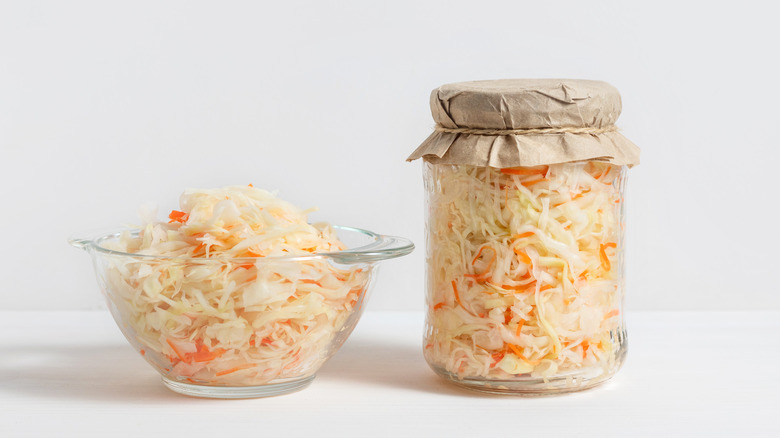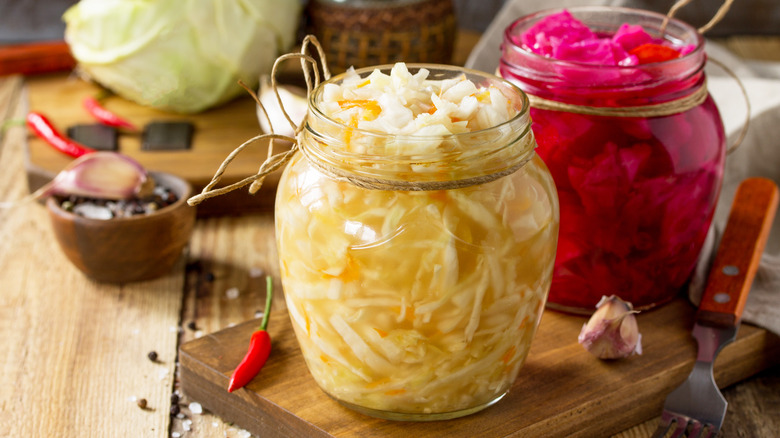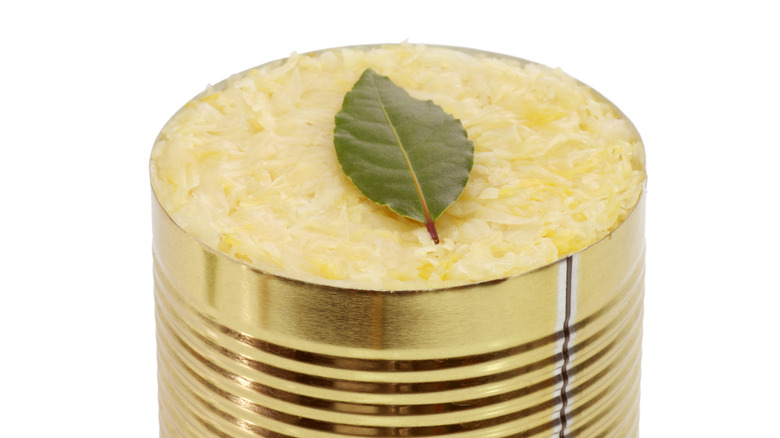Raw Sauerkraut Vs. Canned: What's The Difference?
Most of us think of sauerkraut as being quintessentially German. But actually, this fermented cabbage began more than 2000 years ago, according to German Foods. Chinese people preserved cabbage for the winter by mixing it with rice wine. So, while the name is certainly German, the dish's roots are Asian, not European. But over the centuries, and with the progressive changes in cooking technologies, sauerkraut is now processed primarily in two ways: fermentation and pasteurization. Fermentation remains a method largely unchanged, using salt and spices to preserve foods in an anaerobic environment by creating good bacteria that add nutrients and keep the food from spoiling. Pasteurization, however, is a method of heating up foods to kill off bacteria, but, unfortunately, it doesn't discriminate between the good stuff and the bad.
Sauerkraut comes in these two ways, according to the Cleveland Kitchen, and the results create subtle, and not-so-subtle differences. Both can accompany any number of foods from burgers to hot dogs, from creating unique salsas to serving with eggs. But that's about where the similarities between the two end.
Raw sauerkraut is tangy, crunchy, and full of probiotics
Raw sauerkraut is fermented and comes in jars or sometimes plastic bags in the refrigerated section, tends to be a bit greener, and has a more sour and salty taste, according to Iowa City Moms. KQED did a taste test of a number of raw sauerkraut brands and reported that there is more crunch, more sour and more salt in these versions. Fermentation adds a certain funky element to the cabbage, and though some might say it's an acquired taste, it certainly isn't unpleasant. Raw sauerkraut is also commonly made with different additions like caraway seeds, and other vegetables and spices to provide different flavors.
The primary health benefits of raw sauerkraut are in its fermentation process, according to Cultures For Health. Fermentation involves using yeasts and bacteria to convert sugar and carbohydrates into acids or alcohol. Raw sauerkraut is essentially fermented cabbage, sometimes paired with other vegetables like carrots or onions, and it's rich in probiotics, which promote immune and gut health, according to the National Institutes for Health. The raw version of sauerkraut is so healthy that MedicineNet even recommends eating a tablespoon of it every day.
Canned Sauerkraut loses nutrients through Pasteurization
Where raw sauerkraut is salty and sour, canned sauerkraut is slightly more wilted, and doesn't maintain the same satisfying crunch as its raw cousin. It's also more yellow in appearance, and has a milder, slightly sweeter taste, according to Madison Magazine.
As for probiotic health benefits, compared to raw, canned sauerkraut contains very few. According to Grow Your Pantry, canned sauerkraut is pasteurized, or heated before it is sold, so most of the benefits of fermentation are removed. You'll find it on the dry goods shelves, usually near the pickles, at grocery stores instead of the refrigerated section. Though, canned sauerkraut is not entirely without health benefits — WebMD reports that canned sauerkraut is still a good source of fiber and Vitamin C.
You can also make your own sauerkraut by following a few simple directions with very few ingredients. While properly pasteurizing sauerkraut requires a bit more rigor, making raw sauerkraut at home turns out not to be too hard; and since you'll be doing the work, you'll not only know exactly what's in it, but can get creative with your choice of ingredients. But whether buying some or making it on your own, the health benefits, particularly of the raw version, are well worth the eating.


